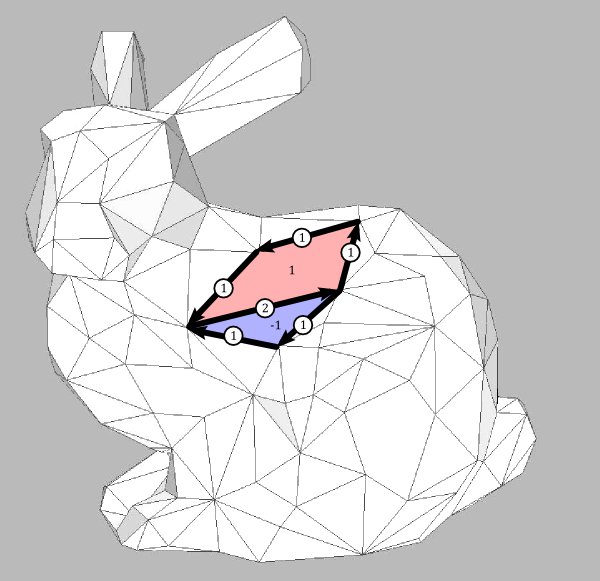The derivative of a 0-form is a function on oriented edges $e$ that records the difference between the values of $f$ at the vertices $\textrm{end}(e)$ and $\textrm{start}(e)$. Similarly, the derivative of a dual 0-form $f$ encodes the difference between the two function values of $f$ on the two sides of $e$: For $f \in \Omega_0(M^*)$ we define
$\partial_2 f: E \rightarrow \mathbb{R}$
$\partial_2 f(e) = f(\textrm{left}(e))-f(\textrm{right}(e))$.
We use the same letters for dual 0-forms and 0-forms, but it will be convenient to use a diffrent letter (pronounced “del”) for the derivative. Formally, $\partial_2 f$ looks like a 1-form, but the meaning is different. So we decide to call an object like the above $\partial_2 f$ a dual 1-form and denote the space of all dual 1-forms by
$\Omega_1(M^*) = \{\eta : E\rightarrow \mathbb{R} \,|\, \eta\circ\rho = -\eta\}$.
Just as we interpreted $\Omega_0(M^*)$ as the dual space of $\Omega_2(M)$ we can define a non-degenerate pairing between dual 1-forms and 1-forms:
$\langle \,,\rangle: \Omega_1(M^*) \times \Omega_1(M) \rightarrow \mathbb{R}$
$\displaystyle\langle \eta,\omega \rangle :=\sum_{e \in \hat{E}}\, \eta(e)\,\omega(e)$.
Just as we did for 1-forms, we can visualize dual 1-forms by writing numbers on arrows. Also here we could reverse any arrow and change the sign of the corresponding number. The picture below shows the derivative of the dual function that is 1 on the red face and -1 on the blue one.

